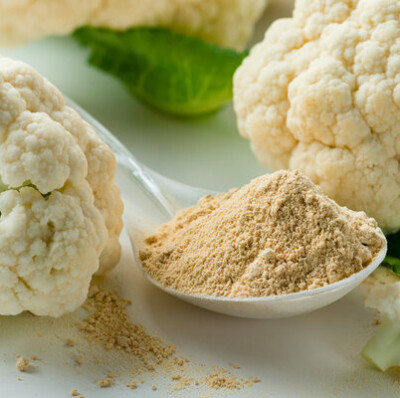Origin
Cauliflower (Brassica oleracea) is one of the oldest cabbage varieties, its cultivation started around 2500 years ago in Italy and Cyprus. Today, it is recognized as one of the most commonly consumed cabbage-like vegetables.2
Current health concerns with gluten-related diseases have led to the development of gluten-free alternatives. This flour is one promising alternative with acceptable sensory properties.1
Function
In baked goods, cauliflower flour serves several functions:1
- Provides structure
- Liquid absorption: a result of the flour’s high water absorption.
- Flavor: imparts a characteristic mild neutral taste.
- Color: sugars in the flour can undergo Maillard browning reaction.
- Nutritional value: a good source of fiber, vitamins, minerals and polyphenols.
Nutrition
Typical nutritional value of commercial flour per 100 g:3
| Component | Grams |
|---|---|
| Carbohydrate | 56.67 |
| Moisture | 20.00 |
| Protein | 20.00 |
| Lipids | 3.33 |
This flour provides 333 kcal per 100 g. It is a good source of fiber, important for digestive health and is rich in vitamins and minerals. 1,3
Production
Homemade cauliflower flour or meal can be prepared through the following process:1
- Conditioning: remove leaves, core and stem of cauliflower floret.
- Blending: florets are blended in a mixer or food processor to a consistency similar to mashed potatoes.
- Drying: the mashed cauliflower is dried in an oven at 177 oC (350 oF) for 15 minutes and should not be allowed to brown.
- Cooling: room temperature cooling.
- Packaging and storage.
Application
It is commonly used to manufacture pizza bases, bread, biscuits, pancakes and cookies. 4,5
Considerations when working:4
- Substitute 1:1 wheat flour: cauliflower flour.
- Cauliflower dough malleability is similar to traditional wheat flour dough.
- Doesn’t disintegrate during baking.
- Provides a distinctive crunch from wheat flour pizza base.
- High water absorption capacity, emulsification, and high bulk density.
Regulations
Cauliflower flour as a unique product doesn’t have a particular regulation by the FDA. However, the FDA does establish the standards for growing, harvesting, packing and holding of the produce.6
In the EU, this flour doesn’t have a specific regulation just like in the US.
References
- Lacey, A. Cali’flour Kitchen: 125 Cauliflower-Based Recipes for the Carbs You Crave. United States, ABRAMS, 2019.
- Kiple, K. F., and Ornelas, K. The Cambridge world history of food. Cambridge University Press, 2000.
- U.S. Department of Agriculture, Agricultural Research Service. FoodData Central, 05 December 2020. https://fdc.nal.usda.gov/fdc-app.html#/food-details/1992015/nutrients . Accessed 28 September 2021.
- Bunch Team. “Bunch Food For Thought”. Bunch.Countdown.Co.Nz, 2020, https://bunch.countdown.co.nz/nzBunch/article/10068875/Have-you-tried-Cauliflower-Flour#?sortby=RECENT . Accessed 28 Sept 2021.
- Kumar, K, et al. “Functional properties of food commodities (wheat, kidney bean, cowpea, turnip, cauliflower) flours.” Int J Crop Sci 5 (2017): 1199-1202.
- Food and Drug Administration (FDA). US Department of Health and Human Services. CFR Code of Federal Regulations Title 21, Part 112 Standards For The Growing, Harvesting, Packing, And Holding Of Produce For Human Consumption, https://www.accessdata.fda.gov/scripts/cdrh/cfdocs/cfCFR/CFRSearch.cfm?CFRPart=112&showFR=1 , Accessed 28 Sept 2021.

